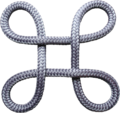Trivial knot
The trivial knot (also: unknot ) is the simplest mathematical knot, namely a simple closed loop that is not knotted (i.e. can be pulled apart to form a smooth ring without cutting). It plays a role in knot theory .
Many knots that occur in practice, for example the trumpet knot and the choke knot , are trivial knots.
A nontrivial knot is a knot that cannot be deformed into the non-knot .
Knot theoretical properties
A curve representing the trivial node is, for example
- .
A knot is a trivial knot if it can be converted into the above curve by means of a constant deformation (without “cutting the cord”). There are certainly complicated looking nodes that are in reality trivial, an example is shown in the picture below on the right.
The Jones polynomial of the trivial knot is:
His Alexander polynomial is also 1.
A node K in the 3-sphere is trivial if and only if the complement is homeomorphic to the full torus.
In 1961, the mathematician Wolfgang Haken developed an algorithm that can be used to determine whether a node diagram shows a trivial node or not. To do this, he used Seifert surfaces and Martin Kneser's theory of normal surfaces . The algorithm is complex and has never been implemented. With this, Haken showed the decidability of the unknot problem. With Haken's algorithm one can generally decide whether two hook manifolds are homeomorphic. (Hook manifolds are irreducible 3-manifolds that contain an incompressible surface - in the case of a node complement, the Seifert surface is this incompressible surface.)
Joel Hass , Jeffrey Lagarias, and Nicholas Pippenger took hooks' theory and showed that the normal surfaces can be represented as integer points on a convex cone (a high-dimensional polytope), with an unknot transformation corresponding to an extremal ray on the cone. The unknot algorithm can then be reduced to an enumeration problem of the knots of this polytope. They proved in 1999 that being untangled in complexity class is NP ; H. a “certificate” that a node is trivial can be verified in polynomial time. Benjamin Burton demonstrated the usefulness of the algorithm for the unknot problem in 2011, even if it did not run in polynomial time.
Assuming that the generalized Riemann Hypothesis is correct, Greg Kuperberg proved in 2011 that being knotted is also in NP. One proof that does not use the Riemann Hypothesis was given by Marc Lackenby in 2016 .
It is not known whether the Jones polynomial can be used to discover the trivial knot; H. whether applies only to the trivial node. However, this is achieved by the Heegaard-Floer homology or the Khovanov homology .
A non-knot algorithm that has also been implemented in practice comes from Joan Birman and Michael Hirsch and uses braid foliations. In 2001, Hass and Lagarias also estimated the number of Reidemeister movements for untying the knot.
Web links
Individual evidence
- ↑ Knotty Topics ( Memento of the original from July 17, 2011 in the Internet Archive ) Info: The archive link was inserted automatically and has not yet been checked. Please check the original and archive link according to the instructions and then remove this notice.
- ↑ Unknot (en) on MathWorld. Accessed September 25, 2012
- ↑ Reich der Unknoten Der Tagesspiegel on the knot theory. Accessed September 25, 2012.
- ↑ Theorem of the Day: Haken's Unknot Theorem (PDF; 255 kB)
- ↑ Haken, Theory of Normal Surfaces, Acta Mathematica, Volume 105, 1961, pp. 245-375
- ↑ Hass, Joel; Lagarias, Jeffrey C .; Pippenger, Nicholas: The computational complexity of knot and link problems , Journal of the ACM 46 (2), 185-211 (1999). Arxiv
- ^ Benjamin A. Burton, maximally admissible faces and asymptotic bounds for the normal surface solution space, Journal of Combinatorial Theory, Series A, Volume 118, 2011, pp. 1410-1435, Arxiv
- ↑ Knots and Complexity Theory
- ↑ Marc Lackenby: The efficient certification of knottedness and Thurston norm
- ↑ Peter Kronheimer , Tomasz Mrowka : Khovanov homology is an unknot-detector , Publications mathématiques de l'IHÉS, June 2011, Volume 113, Issue 1, pp 97–208.
- ^ Joan Birman, Michael Hirsch: A new algorithm for recognizing the unknot, Geometry and Topology, Volume 2, 1998, pp. 178-220, Arxiv
- ^ Hass, Lagarias, The number of Reidemeister moves needed for unknotting, Journal of the American Mathematical Society, Volume 14, 2001, pp. 399-428, Arxiv






